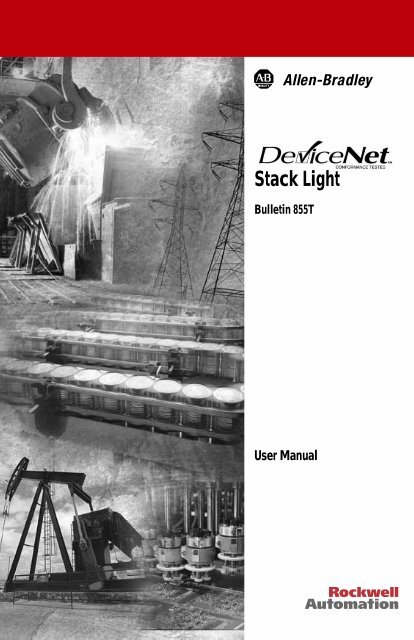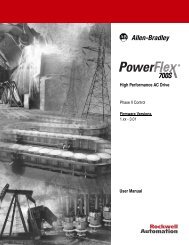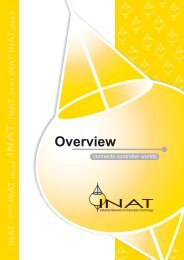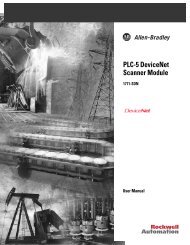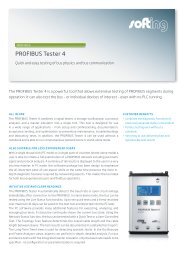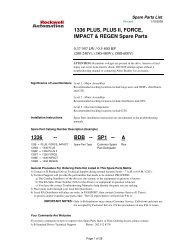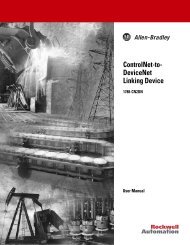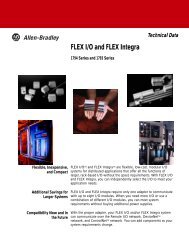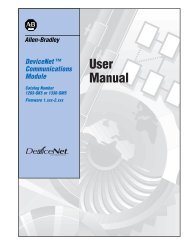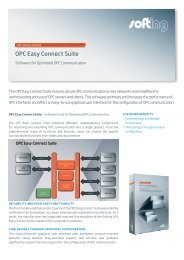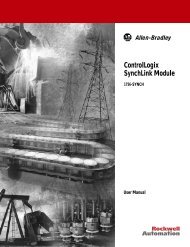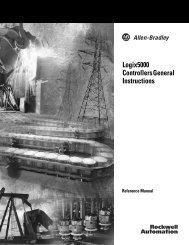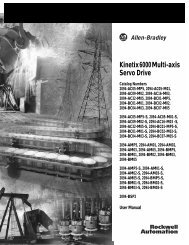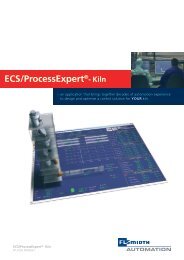Overview of DeviceNet Stack Light
Overview of DeviceNet Stack Light
Overview of DeviceNet Stack Light
You also want an ePaper? Increase the reach of your titles
YUMPU automatically turns print PDFs into web optimized ePapers that Google loves.
<strong>Stack</strong> <strong>Light</strong><br />
Bulletin 855T<br />
User Manual
Important User Information<br />
Because <strong>of</strong> the variety <strong>of</strong> uses for the products described in this publication, those responsible<br />
for the application and use <strong>of</strong> this control equipment must satisfy themselves that all<br />
necessary steps have been taken to assure that each application and use meets all performance<br />
and safety requirements, including any applicable laws, regulations, codes and standards.<br />
The illustrations, charts, sample programs and layout examples shown in this guide are<br />
intended solely for purposes <strong>of</strong> example. Since there are many variables and requirements<br />
associated with any particular installation, Allen-Bradley does not assume responsibility or<br />
liability (to include intellectual property liability) for actual use based upon the examples<br />
shown in this publication.<br />
Allen-Bradley publication SGI-1.1, Safety Guidelines for the Application, Installation and Maintenance<br />
<strong>of</strong> Solid-State Control (available from your local Allen-Bradley <strong>of</strong>fice), describes some important<br />
differences between solid-state equipment and electromechanical devices that should be taken<br />
into consideration when applying products such as those described in this publication.<br />
Reproduction <strong>of</strong> the contents <strong>of</strong> this copyrighted publication, in whole or part, without<br />
written permission <strong>of</strong> Rockwell Automation, is prohibited.
Throughout this manual we use notes to make you aware <strong>of</strong> safety considerations:<br />
ATTENTION<br />
Identifies information about practices or circumstances that can lead<br />
to personal injury or death, property damage or economic loss<br />
!<br />
Attention statements help you to:<br />
• identify a hazard<br />
• avoid a hazard<br />
• recognize the consequences<br />
IMPORTANT<br />
Identifies information that is critical for successful application and<br />
understanding <strong>of</strong> the product.<br />
Allen-Bradley is a trademark <strong>of</strong> Rockwell Automation<br />
<strong>DeviceNet</strong> is a trademark <strong>of</strong> the Open <strong>DeviceNet</strong> Vendor Association (ODVA).<br />
European Communities (EC) Directive Compliance<br />
If this product has the CE mark it is approved for installation within the European Union and<br />
EEA regions. It has been designed and tested to meet the following directives.<br />
EMC Directive<br />
This product is tested to meet the Council Directive 89/336/EC Electromagnetic<br />
Compatibility (EMC) by applying the following standards, in whole or in part, documented in<br />
a technical construction file:<br />
• EN 50081-2 EMC — Generic Emission Standard, Part 2 — Industrial Environment<br />
• EN 50082-2 EMC — Generic Immunity Standard, Part 2 — Industrial Environment<br />
This product is intended for use in an industrial environment.
Low Voltage Directive<br />
This product is not required to meet Council Directive 73/23/EEC Low Voltage, as it is<br />
designed for use with a voltage rating below 50V for alternating current and below 75V for<br />
direct current. The requirements <strong>of</strong> EN 60947-5-1:1997 Low-Voltage Switchgear and<br />
Controlgear, Part 5 - Control Circuit Devices, have been applied.
Table <strong>of</strong> Contents<br />
Preface<br />
Intended Audience . . . . . . . . . . . . . . . . . . . . . . . . . . . . . . . . . . . . . . . . i<br />
Contents <strong>of</strong> Manual . . . . . . . . . . . . . . . . . . . . . . . . . . . . . . . . . . . . . . . i<br />
Related Publications . . . . . . . . . . . . . . . . . . . . . . . . . . . . . . . . . . . . . . . ii<br />
EDS Web Site . . . . . . . . . . . . . . . . . . . . . . . . . . . . . . . . . . . . . . . . . . . . ii<br />
Chapter 1 — <strong>Overview</strong> <strong>of</strong> <strong>DeviceNet</strong> <strong>Stack</strong> <strong>Light</strong><br />
Chapter Objectives . . . . . . . . . . . . . . . . . . . . . . . . . . . . . . . . . . . . . . 1-1<br />
Description . . . . . . . . . . . . . . . . . . . . . . . . . . . . . . . . . . . . . . . . . . . . 1-1<br />
Base Features. . . . . . . . . . . . . . . . . . . . . . . . . . . . . . . . . . . . . . . . . . . 1-2<br />
Module Positions . . . . . . . . . . . . . . . . . . . . . . . . . . . . . . . . . . . . . . . 1-3<br />
Rotary Switches. . . . . . . . . . . . . . . . . . . . . . . . . . . . . . . . . . . . . . . . . 1-3<br />
<strong>DeviceNet</strong> Connection. . . . . . . . . . . . . . . . . . . . . . . . . . . . . . . . . . . 1-3<br />
Typical <strong>DeviceNet</strong> Configuration . . . . . . . . . . . . . . . . . . . . . . . . . . 1-4<br />
<strong>DeviceNet</strong> Components. . . . . . . . . . . . . . . . . . . . . . . . . . . . . . . . . . 1-5<br />
Replacement Parts. . . . . . . . . . . . . . . . . . . . . . . . . . . . . . . . . . . . . . . 1-5<br />
Chapter 2 — Quick Start<br />
Chapter Objectives . . . . . . . . . . . . . . . . . . . . . . . . . . . . . . . . . . . . . . 2-1<br />
Data Rate Configuration. . . . . . . . . . . . . . . . . . . . . . . . . . . . . . . . . . 2-1<br />
Node Address Configuration . . . . . . . . . . . . . . . . . . . . . . . . . . . . . . 2-2<br />
Installing the Modules . . . . . . . . . . . . . . . . . . . . . . . . . . . . . . . . . . . 2-2<br />
Connection to the Network . . . . . . . . . . . . . . . . . . . . . . . . . . . . . . . 2-2<br />
<strong>Stack</strong> <strong>Light</strong> Parameter Configuration. . . . . . . . . . . . . . . . . . . . . . . . 2-3<br />
Scanner Configuration . . . . . . . . . . . . . . . . . . . . . . . . . . . . . . . . . . . .2-6<br />
Chapter 3 — Installation and Mounting<br />
Chapter Objectives . . . . . . . . . . . . . . . . . . . . . . . . . . . . . . . . . . . . . . 3-1<br />
<strong>DeviceNet</strong> Guidelines. . . . . . . . . . . . . . . . . . . . . . . . . . . . . . . . . . . . 3-1<br />
Equipment Needed. . . . . . . . . . . . . . . . . . . . . . . . . . . . . . . . . . . . . . 3-1<br />
Setting the Rotary Switches . . . . . . . . . . . . . . . . . . . . . . . . . . . . . . . 3-1<br />
<strong>DeviceNet</strong> <strong>Stack</strong> <strong>Light</strong> Base Dimensions . . . . . . . . . . . . . . . . . . . . 3-4<br />
Mounting the <strong>DeviceNet</strong> <strong>Stack</strong> <strong>Light</strong> . . . . . . . . . . . . . . . . . . . . . . . 3-5<br />
Publication 855T-UM001B-EN-P September 2000
Table <strong>of</strong> Contents<br />
Chapter 4 — Operations<br />
Chapter Objectives . . . . . . . . . . . . . . . . . . . . . . . . . . . . . . . . . . . . . . 4-1<br />
Modes <strong>of</strong> Operation . . . . . . . . . . . . . . . . . . . . . . . . . . . . . . . . . . . . . 4-1<br />
Resetting the Device . . . . . . . . . . . . . . . . . . . . . . . . . . . . . . . . . . . . . 4-6<br />
<strong>DeviceNet</strong> Operations. . . . . . . . . . . . . . . . . . . . . . . . . . . . . . . . . . . . 4-6<br />
Chapter 5 — Troubleshooting and Maintenance<br />
Chapter Objectives . . . . . . . . . . . . . . . . . . . . . . . . . . . . . . . . . . . . . . 5-1<br />
Preventive Maintenance . . . . . . . . . . . . . . . . . . . . . . . . . . . . . . . . . . 5-1<br />
LED Indicators . . . . . . . . . . . . . . . . . . . . . . . . . . . . . . . . . . . . . . . . . 5-2<br />
Troubleshooting . . . . . . . . . . . . . . . . . . . . . . . . . . . . . . . . . . . . . . . . 5-2<br />
Bulb Burnout . . . . . . . . . . . . . . . . . . . . . . . . . . . . . . . . . . . . . . . . . . . 5-3<br />
Appendix A — Specifications<br />
Certifications . . . . . . . . . . . . . . . . . . . . . . . . . . . . . . . . . . . . . . . . . . A-2<br />
Special Notes . . . . . . . . . . . . . . . . . . . . . . . . . . . . . . . . . . . . . . . . . . A-2<br />
Appendix B — <strong>DeviceNet</strong> Information<br />
General Information . . . . . . . . . . . . . . . . . . . . . . . . . . . . . . . . . . . . B-1<br />
Message Types . . . . . . . . . . . . . . . . . . . . . . . . . . . . . . . . . . . . . . . . . B-1<br />
Class Services . . . . . . . . . . . . . . . . . . . . . . . . . . . . . . . . . . . . . . . . . . B-1<br />
Object Classes . . . . . . . . . . . . . . . . . . . . . . . . . . . . . . . . . . . . . . . . . B-2<br />
Publication 855T-UM001B-EN-P September 2000
Preface<br />
This manual gives an overview <strong>of</strong> the Bulletin 855T <strong>DeviceNet</strong> <strong>Stack</strong> <strong>Light</strong> and describes<br />
how to configure, install, operate, and troubleshoot the device on the <strong>DeviceNet</strong> Network.<br />
Intended Audience<br />
This manual is for the individuals responsible for installing, mounting, and operating the<br />
855T <strong>DeviceNet</strong> <strong>Stack</strong> <strong>Light</strong> in an industrial environment.<br />
You should understand <strong>DeviceNet</strong> Network operations, including how slave devices<br />
operate on the network and communicate with a <strong>DeviceNet</strong> Master.<br />
Contents <strong>of</strong> Manual<br />
This manual is organized as follows:<br />
Table P.A<br />
Chapter Title Description<br />
— Preface Describes the purpose and contents <strong>of</strong> the manual,<br />
and the intended audience.<br />
1 <strong>Overview</strong> <strong>of</strong> <strong>DeviceNet</strong> <strong>Stack</strong> <strong>Light</strong> Provides an overview <strong>of</strong> the 855T <strong>DeviceNet</strong> <strong>Stack</strong><br />
<strong>Light</strong> and its features.<br />
2 Quick Start Describes how to get the <strong>DeviceNet</strong> <strong>Stack</strong> <strong>Light</strong><br />
operating on the network.<br />
3 Installation and Mounting Describes how to configure, mount, and install the<br />
855T <strong>DeviceNet</strong> <strong>Stack</strong> <strong>Light</strong> device on the<br />
<strong>DeviceNet</strong> Network.<br />
4 Operations Describes 855T <strong>DeviceNet</strong> <strong>Stack</strong> <strong>Light</strong> operations<br />
and other pertinent information.<br />
5 Troubleshooting and Maintenance Provides information on how to troubleshoot and<br />
maintain the device.<br />
A Specifications Provides 855T <strong>DeviceNet</strong> <strong>Stack</strong> <strong>Light</strong> specifications.<br />
B <strong>DeviceNet</strong> Information Describes <strong>DeviceNet</strong> message types, class services,<br />
and object classes supported by the 855T<br />
<strong>DeviceNet</strong> <strong>Stack</strong> <strong>Light</strong>.<br />
Publication 855T-UM001B-EN-P September 2000
ii<br />
Preface<br />
Related Publications<br />
The following table lists <strong>DeviceNet</strong> Network related publications.<br />
Table P.B<br />
Publication Title<br />
Publication No.<br />
<strong>DeviceNet</strong> Cable System Planning and Installation Manual DN-6.7.2 - May 1999<br />
1756-DNB Scanner Module Configuration 1756-6.5.15<br />
EDS Web Site<br />
EDS files are available for downloading at: http://www.ab.com/networks/eds<br />
Publication 855T-UM001B-EN-P September 2000
Chapter 1<br />
<strong>Overview</strong> <strong>of</strong> <strong>DeviceNet</strong> <strong>Stack</strong> <strong>Light</strong><br />
Chapter Objectives<br />
This chapter provides an overview <strong>of</strong> the <strong>DeviceNet</strong> <strong>Stack</strong> <strong>Light</strong> and its features. It contains<br />
the following sections:<br />
Table 1.A<br />
Section Page Section Page<br />
Description 1-1 <strong>DeviceNet</strong> Connection 1-3<br />
Base Features 1-2 Typical <strong>DeviceNet</strong> Configuration 1-4<br />
Module Positions 1-3 <strong>DeviceNet</strong> Components 1-5<br />
Rotary Switches 1-3 Replacement Parts 1-5<br />
Description<br />
The 855T Control Tower <strong>Stack</strong> <strong>Light</strong> line <strong>of</strong>fers <strong>DeviceNet</strong> Bases for applications where<br />
network communication is desired. All <strong>of</strong> the functionality for the <strong>DeviceNet</strong> Interface is<br />
contained within the mounting base. All light and sound modules for the 855T Control<br />
Tower <strong>Stack</strong> <strong>Light</strong> line are compatible with the standard bases, or with <strong>DeviceNet</strong> Bases.<br />
The entire stack is powered from the <strong>DeviceNet</strong> Network. A separate power supply is not<br />
required.<br />
The 855T Control Tower <strong>Stack</strong> <strong>Light</strong> <strong>DeviceNet</strong> Bases allow up to five light modules, four<br />
light modules plus a combination light and sound module, four light modules plus a<br />
single-tone sound module, three light modules plus a dual-tone sound module, or three light<br />
modules plus a dual-circuit light and sound module.<br />
Publication 855T-UM001B-EN-P September 2000
1-2 <strong>Overview</strong> <strong>of</strong> <strong>DeviceNet</strong> <strong>Stack</strong> <strong>Light</strong><br />
Summary <strong>of</strong> Features<br />
• Standard or assembled configurations<br />
• Surface mounting, pole mounting (10 cm or 25 cm), vertical mounting, and conduit<br />
mounting available<br />
• Allows the use <strong>of</strong> up to five modules in one stack<br />
• NEMA Type 4/4X/13 environmental rating and IP65 environmental rating<br />
• Easy installation and startup<br />
• <strong>DeviceNet</strong> connectivity<br />
• Powered by <strong>DeviceNet</strong> connection (no power supply required)<br />
• Available with stranded wire, micro connector, or mini connector<br />
• <strong>DeviceNet</strong> Cable is pre-wired to all bases<br />
Base Features<br />
Figure 1.1<br />
Rotary<br />
Switches<br />
855T<br />
Base<br />
<strong>DeviceNet</strong><br />
Connector<br />
Publication 855T-UM001B-EN-P September 2000
<strong>Overview</strong> <strong>of</strong> <strong>DeviceNet</strong> <strong>Stack</strong> <strong>Light</strong> 1-3<br />
Module Positions<br />
Figure 1.2<br />
2<br />
4<br />
5<br />
3<br />
1<br />
Rotary Switches<br />
The <strong>DeviceNet</strong> <strong>Stack</strong> <strong>Light</strong> has three 10-position rotary switches for setting:<br />
• <strong>DeviceNet</strong> Data Rate<br />
• <strong>DeviceNet</strong> Node Address<br />
The rotary switches are located on the circuit board on the top <strong>of</strong> the base. The switch<br />
settings and functions are shown below.<br />
Figure 1.3<br />
Data<br />
Rate<br />
Node<br />
Address<br />
4<br />
6<br />
4<br />
6<br />
4<br />
6<br />
2 8<br />
0<br />
2 8<br />
0<br />
MSD<br />
2 8<br />
0<br />
LSD<br />
<strong>DeviceNet</strong> Connection<br />
The <strong>DeviceNet</strong> <strong>Stack</strong> <strong>Light</strong> receives all power and communications through the <strong>DeviceNet</strong><br />
Cable. A separate power supply is not required. This is the only external connection to the<br />
<strong>DeviceNet</strong> <strong>Stack</strong> <strong>Light</strong>.<br />
Publication 855T-UM001B-EN-P September 2000
1-4 <strong>Overview</strong> <strong>of</strong> <strong>DeviceNet</strong> <strong>Stack</strong> <strong>Light</strong><br />
The <strong>DeviceNet</strong> <strong>Stack</strong> <strong>Light</strong> connects to the <strong>DeviceNet</strong> Network using a cable with a micro<br />
connector, a mini connector, or an open-style connector.<br />
Table 1.B <strong>DeviceNet</strong> Micro Connector<br />
Micro Connector Pin # Signal Function Color<br />
1 DRAIN 4 WHITE<br />
5 BLUE<br />
2 RED 3 BLACK<br />
1 SHIELD SHIELD Uninsulated<br />
2 VDC+ Power Supply Red<br />
3 COM Common Black<br />
4 CAN_H Signal High White<br />
5 CAN_L Signal Low Blue<br />
Table 1.C <strong>DeviceNet</strong> Mini Connector<br />
Mini Connector Pin # Signal Function Color<br />
1<br />
5<br />
1 SHIELD SHIELD Uninsulated<br />
2 VDC+ Power Supply Red<br />
3 COM Common Black<br />
2<br />
3<br />
4<br />
4 CAN_H Signal High White<br />
5 CAN_L Signal Low Blue<br />
Table 1.D <strong>DeviceNet</strong> Open-Style Connector<br />
Open-Style Connector Signal Function Color<br />
COM Common Black<br />
V-(black)<br />
V+(red)<br />
Drain Wire (bare)<br />
CAN_H (white)<br />
CAN_L (blue)<br />
CAN_L Signal Low Blue<br />
SHIELD Shield Uninsulated<br />
CAN_H Signal High White<br />
VDC+ Power Supply Red<br />
Typical <strong>DeviceNet</strong> Configuration<br />
A <strong>DeviceNet</strong> Network supports multiple <strong>Stack</strong> <strong>Light</strong> devices and allows them to<br />
communicate with other network devices (up to 64).<br />
The <strong>DeviceNet</strong> <strong>Stack</strong> <strong>Light</strong> operates on the network as a slave device. It does not initiate<br />
communications except for a duplicate node address check on power-up. The master writes<br />
data to, and receives data back from, the <strong>DeviceNet</strong> <strong>Stack</strong> <strong>Light</strong>.<br />
The following <strong>DeviceNet</strong> configuration shows a variety <strong>of</strong> products operating as slaves to a<br />
PLC-5 controller with a 1771-SDN <strong>DeviceNet</strong> Scanner Module.<br />
Publication 855T-UM001B-EN-P September 2000
<strong>Overview</strong> <strong>of</strong> <strong>DeviceNet</strong> <strong>Stack</strong> <strong>Light</strong> 1-5<br />
Figure 1.4<br />
<strong>DeviceNet</strong> Scanner Module<br />
PLC-5 Controller<br />
<strong>DeviceNet</strong> Network<br />
Sensor<br />
Block I/O<br />
SMC<br />
RediSTATION<br />
Drive<br />
Smart Motor Controller<br />
<strong>Stack</strong> <strong>Light</strong><br />
<strong>DeviceNet</strong> Components<br />
<strong>DeviceNet</strong> Cables and components are available from Allen-Bradley as separate cat. nos.<br />
It is your responsibility to install and implement the <strong>DeviceNet</strong> Network and supported<br />
devices according to the <strong>DeviceNet</strong> guidelines.<br />
Replacement Parts<br />
The <strong>DeviceNet</strong> <strong>Stack</strong> <strong>Light</strong> Bases and pre-assembled stacks come with all the parts required<br />
to install and use the product. The installer needs only to supply the mounting hardware.<br />
Replacement parts for 855T components (modules, replacement gaskets, and replacement<br />
lamps) are available as separate cat. nos. Refer to the Control Tower <strong>Stack</strong> <strong>Light</strong>s Selection Guide<br />
(Publication 855T-SG001A-US-P) or the Industrial Controls Catalog.<br />
Publication 855T-UM001B-EN-P September 2000
Chapter 2<br />
Quick Start<br />
Chapter Objectives<br />
This chapter provides the necessary steps to get the <strong>DeviceNet</strong> <strong>Stack</strong> <strong>Light</strong> operating on the<br />
network. It contains the following sections:<br />
Table 2.A<br />
Section Page Section Page<br />
Data Rate Configuration 2-1 Connection to the Network 2-2<br />
Node Address Configuration 2-2 <strong>Stack</strong> <strong>Light</strong> Parameter Configuration 2-3<br />
Installing the Modules 2-2 — —<br />
Data Rate Configuration<br />
Rotary switch 3 (S3) sets the data rate at which the <strong>DeviceNet</strong> <strong>Stack</strong> <strong>Light</strong> communicates on<br />
the <strong>DeviceNet</strong> Network. The factory default setting is 125 KB.<br />
Figure 2.1<br />
DATA<br />
RATE PGM<br />
500K<br />
250K<br />
125K<br />
4 6 NODE ADDRESS 4 6<br />
NOT (00 – 63, PGM)<br />
USED 2<br />
2 8<br />
PGM<br />
MSD 0<br />
LSD 0<br />
For more information on data rate configuration, refer to Chapter 3 — Installation and<br />
Mounting (Setting the Data Rate).<br />
Publication 855T-UM001B-EN-P September 2000
Quick Start 2-2<br />
Node Address Configuration<br />
Rotary switches 1 (S1) and 2 (S2) set the node address (0…63) <strong>of</strong> the stack light on the<br />
<strong>DeviceNet</strong> Network. The factory default is 63.<br />
Figure 2.2<br />
DATA<br />
RATE PGM<br />
500K<br />
250K<br />
125K<br />
4 6 NODE ADDRESS 4 6<br />
NOT (00 – 63, PGM)<br />
USED 2<br />
2 8<br />
PGM<br />
MSD 0<br />
LSD 0<br />
For more information on node address configuration, refer to Chapter 3 — Installation and<br />
Mounting (Setting the <strong>DeviceNet</strong> Node Address).<br />
Installing the Modules<br />
The stack light modules are installed to the base by placing a sealing o-ring between the base<br />
and the module, lining up the arrow on the bottom <strong>of</strong> the module with the line on the top <strong>of</strong><br />
the prior module or base, and twisting the top module clockwise to lock them into place.<br />
IMPORTANT<br />
The <strong>DeviceNet</strong> Base is compatible with all 24V DC 855T modules.<br />
For more information on different modules, refer to the Control Tower <strong>Stack</strong> <strong>Light</strong>s Selection<br />
Guide (Publication 855T-SG001A-US-P) or the Industrial Controls Catalog.<br />
Connection to the Network<br />
Wire the <strong>DeviceNet</strong> <strong>Stack</strong> <strong>Light</strong> to an operating network. If the device is an 855T-DSxxxx,<br />
the wires should be connected to a terminal block. If the device is an 855T-DMxxxx or<br />
855T-DLxxxx, it will be connected with the quick disconnect connector. The device is fully<br />
powered by the network, therefore it is important that the device is located near a power<br />
supply.<br />
For more information on system installation, refer to the <strong>DeviceNet</strong> Cable System — Planning<br />
and Installation Manual (Publication DN-6.7.2 - May 1999).<br />
Publication 855T-UM001B-EN-P September 2000
2-3 Quick Start<br />
<strong>Stack</strong> <strong>Light</strong> Parameter Configuration<br />
For proper operation, the parameters <strong>of</strong> the stack light must be configured. There are several<br />
different parameters that can be configured, but the critical parameters are Module Type and<br />
Module Mode. The parameters can be configured using RSNetWorx for <strong>DeviceNet</strong>.<br />
Figure 2.3<br />
To access the parameter configuration screen from the on-line view, double-click the stack<br />
light icon.<br />
Publication 855T-UM001B-EN-P September 2000
Quick Start 2-4<br />
Figure 2.4<br />
Select the Device Parameters tab.<br />
Publication 855T-UM001B-EN-P September 2000
2-5 Quick Start<br />
Figure 2.5<br />
The stack light will work without any parameter changes, but for flashing patterns and bulb<br />
burnout detection, parameters must be changed. For more information on device<br />
configuration, refer to Chapter 4 — Operations (Modes <strong>of</strong> Operation) and RSNetWorx for<br />
<strong>DeviceNet</strong> documentation.<br />
Publication 855T-UM001B-EN-P September 2000
Quick Start 2-6<br />
Scanner Configuration<br />
For proper operation, the scanner must be configured. The following graphics show the<br />
configuration <strong>of</strong> a 1756-DNB from the RSNetWorx for <strong>DeviceNet</strong> s<strong>of</strong>tware.<br />
Figure 2.6<br />
To access the Scanner Module Configuration screen from an on-line view, double-click the<br />
1756-DNB scanner icon.<br />
Publication 855T-UM001B-EN-P September 2000
2-7 Quick Start<br />
Figure 2.7<br />
To access the Scanlist Editor, select the Scanlist tab.<br />
Publication 855T-UM001B-EN-P September 2000
Quick Start 2-8<br />
Figure 2.8<br />
Add <strong>Stack</strong> <strong>Light</strong> <strong>DeviceNet</strong> Base to the Scanlist. Select the device in the Available Devices<br />
list. To have the s<strong>of</strong>tware automatically assign I/O addresses, select the Automap on Add<br />
selection box. Click the > button.<br />
Publication 855T-UM001B-EN-P September 2000
2-9 Quick Start<br />
Figure 2.9<br />
To view/edit I/O parameters, click Edit I/O Parameters.<br />
Publication 855T-UM001B-EN-P September 2000
Quick Start 2-10<br />
Figure 2.10<br />
To view/edit the mapping <strong>of</strong> the input data, click Cancel or OK to return to the Scanner<br />
Module screen. Select the Input tab.<br />
Publication 855T-UM001B-EN-P September 2000
2-11 Quick Start<br />
Figure 2.11<br />
To view/edit the mapping <strong>of</strong> the output data, select the Output tab.<br />
Publication 855T-UM001B-EN-P September 2000
Quick Start 2-12<br />
Figure 2.12<br />
For more information on scanner configuration, refer to the <strong>DeviceNet</strong> Scanner Configuration<br />
manual (Publication 1756-6.5.15) for the ControlLogix platform.<br />
Publication 855T-UM001B-EN-P September 2000
Chapter 3<br />
Installation and Mounting<br />
Chapter Objectives<br />
This chapter describes how to install and mount a standard or custom <strong>DeviceNet</strong> <strong>Stack</strong> <strong>Light</strong>.<br />
It contains the following sections:<br />
Table 3.A<br />
Section Page Section Page<br />
<strong>DeviceNet</strong> Guidelines 3-1 <strong>DeviceNet</strong> <strong>Stack</strong> <strong>Light</strong> Base Dimensions 3-4<br />
Equipment Needed 3-1 Mounting the <strong>DeviceNet</strong> <strong>Stack</strong> <strong>Light</strong> 3-5<br />
Setting the Rotary Switches 3-1 — —<br />
<strong>DeviceNet</strong> Guidelines<br />
It is your responsibility to install and implement the <strong>DeviceNet</strong> Network and supported<br />
devices according to the <strong>DeviceNet</strong> guidelines.<br />
Equipment Needed<br />
Install the <strong>DeviceNet</strong> <strong>Stack</strong> <strong>Light</strong> using standard electrician’s tools:<br />
• Slotted screwdriver <strong>of</strong> standard and small sizes (one small screwdriver, required for<br />
setting rotary switches, is included with the product)<br />
Setting the Rotary Switches<br />
The settings <strong>of</strong> the rotary switches on the circuit board determine:<br />
• <strong>DeviceNet</strong> Data Rate<br />
• <strong>DeviceNet</strong> Node Address<br />
Publication 855T-UM001B-EN-P September 2000
Installation and Mounting 3-2<br />
The location <strong>of</strong> the rotary switches is shown below.<br />
Figure 3.1<br />
Data<br />
Rate<br />
Node<br />
Address<br />
S3<br />
S2<br />
S1<br />
Setting the Data Rate<br />
Rotary switch 3 (S3) sets the data rate at which the <strong>DeviceNet</strong> <strong>Stack</strong> <strong>Light</strong> communicates on<br />
the <strong>DeviceNet</strong> Network. The factory default setting is 125 KB.<br />
Figure 3.2<br />
DATA<br />
RATE PGM<br />
500K<br />
250K<br />
125K<br />
4 6 NODE ADDRESS 4 6<br />
NOT (00 – 63, PGM)<br />
USED 2<br />
2 8<br />
PGM<br />
MSD 0<br />
LSD 0<br />
Publication 855T-UM001B-EN-P September 2000
3-3 Installation and Mounting<br />
The data rate determines the maximum length <strong>of</strong> the <strong>DeviceNet</strong> Cable.<br />
Table 3.B<br />
Position Data Rate Cable Length (Max.)<br />
0 125 KB 500 m (1600 ft)<br />
1 250 KB 200 m (600 ft)<br />
2 500 KB 100 m (300 ft)<br />
3 Autobaud See above, based on data rate <strong>of</strong> connected network<br />
To set the <strong>DeviceNet</strong> data rate:<br />
1. Refer to the table above to select the correct data rate.<br />
2. If automatic baud rate selection is desired, set switch 3 (S3) in position 3. This<br />
disables the switch and allows the device to sync to an operational network (if<br />
Autobaud is disabled through parameter setup, this position is not valid).<br />
Setting the <strong>DeviceNet</strong> Node Address<br />
Rotary switches 1 (S1) and 2 (S2) set the node address (0…63) <strong>of</strong> the stack light on the<br />
<strong>DeviceNet</strong> Network. The factory default is 63.<br />
Figure 3.3<br />
DATA<br />
RATE PGM<br />
500K<br />
250K<br />
125K<br />
To set the <strong>DeviceNet</strong> node address:<br />
4 6 NODE ADDRESS 4 6<br />
NOT (00 – 63, PGM)<br />
USED 2<br />
2 8<br />
PGM<br />
MSD 0<br />
LSD 0<br />
1. Set Most Significant Digit (MSD) Switch, switch 2 (S2), to tens position. For example,<br />
if the desired node address is 27, set switch 2 (S2) to 2.<br />
2. Set Least Significant Digit (LSD) Switch, switch 1 (S1), to ones position. For example,<br />
if the desired node address is 27, set switch 1 (S1) to 7.<br />
3. If s<strong>of</strong>tware programmability is desired, set the node address to 64 or greater. This<br />
disables both switches and allows programming through the network. S<strong>of</strong>tware will<br />
default to 63.<br />
Publication 855T-UM001B-EN-P September 2000
Installation and Mounting 3-4<br />
<strong>DeviceNet</strong> <strong>Stack</strong> <strong>Light</strong> Base Dimensions<br />
Figure 3.4 shows the dimensions <strong>of</strong> the <strong>Stack</strong> <strong>Light</strong> Bases. Dimensions in millimeters (inches).<br />
Dimensions are not intended to be used for manufacturing purposes.<br />
Figure 3.4 <strong>Stack</strong> <strong>Light</strong> Base Dimensions<br />
20.8<br />
(0.8)<br />
4.5<br />
(0.2)<br />
69.0<br />
(2.7)<br />
PG16 or<br />
1/2" NPT<br />
Conduit Thread<br />
124.5<br />
(4.9)<br />
45.0<br />
(1.8)<br />
Surface Mount Base<br />
54.0<br />
(2.1)<br />
54.0<br />
(2.1)<br />
70.0<br />
(2.8)<br />
5.0<br />
(0.2)<br />
10 cm Pole Mount Base<br />
65.3<br />
(2.6)<br />
40.3<br />
(1.6)<br />
274.5<br />
(10.8)<br />
5.2<br />
(0.2)<br />
Vertical Mount Base<br />
45.0<br />
(1.8)<br />
54.0<br />
(2.1)<br />
70.0<br />
(2.8)<br />
30.0<br />
(1.2)<br />
54.0<br />
(2.1)<br />
5.0<br />
(0.2)<br />
25 cm Pole Mount Base<br />
Tube Mount Base<br />
Publication 855T-UM001B-EN-P September 2000
3-5 Installation and Mounting<br />
Mounting the <strong>DeviceNet</strong> <strong>Stack</strong> <strong>Light</strong><br />
Dimensions in millimeters (inches). Dimensions are not intended to be used for<br />
manufacturing purposes.<br />
Figure 3.5 <strong>Stack</strong> <strong>Light</strong> Mounting<br />
45,0<br />
(1 25/32)<br />
Ø5,2<br />
(13/64)<br />
M4<br />
(#8)<br />
Ø4,5<br />
(11/64)<br />
Ø11,5<br />
(15/32)<br />
M5<br />
(#10)<br />
Ø10,0<br />
(25/64)<br />
M5<br />
(#10)<br />
mm<br />
(in.)<br />
38,0<br />
(1 1/2)<br />
45,0<br />
(1 25/32)<br />
2<br />
89 N<br />
(20 lb)<br />
38,0<br />
(1 1/2)<br />
1<br />
3<br />
Ø25,0<br />
(63/64)<br />
4<br />
855T - xTM<br />
1,1 Nm<br />
(10 lb-in.)<br />
3 mm (M6 X 16)<br />
Publication 855T-UM001B-EN-P September 2000
Chapter 4<br />
Operations<br />
Chapter Objectives<br />
This chapter contains the following sections:<br />
Table 4.A<br />
Section Page Section Page<br />
Modes <strong>of</strong> Operation 4-1 <strong>DeviceNet</strong> Operations 4-6<br />
Resetting the Device 4-6 — —<br />
Modes <strong>of</strong> Operation<br />
The 855T <strong>DeviceNet</strong> <strong>Stack</strong> <strong>Light</strong> has three operating modes:<br />
• Power-up/Reset Mode<br />
• Run Mode<br />
• Error Mode<br />
Power-Up/Reset Mode<br />
During a power-up or reset, the 855T <strong>DeviceNet</strong> <strong>Stack</strong> <strong>Light</strong>:<br />
1. Clears outputs (turns outputs <strong>of</strong>f).<br />
2. Performs power-up diagnostic tests including:<br />
• Flash Checksum Test<br />
• Module Test<br />
• CAN Interface test<br />
Publication 855T-UM001B-EN-P September 2000
4-2 Operations<br />
3. Reads and stores baud rate setting. If Autobaud is set, device synchronizes to the<br />
network.<br />
IMPORTANT<br />
Rotary switches are only read in power-up or reset mode.<br />
4. Reads and stores MAC ID setting. Performs Duplicate MAC ID check.<br />
If a duplicate node occurs, the output turns <strong>of</strong>f. You must cycle power to clear the error.<br />
Run Mode<br />
After a successful power-up or reset, the 855T <strong>DeviceNet</strong> <strong>Stack</strong> <strong>Light</strong> enters run mode and<br />
operates as a slave device to a master device.<br />
In normal operation the device will permit configuration <strong>of</strong> each module into any <strong>of</strong> the<br />
following operating modes. Configuration is done over the network using <strong>DeviceNet</strong><br />
Manager or RSNetWorx s<strong>of</strong>tware. The default operating mode is 5, controlled through PLC.<br />
Table 4.B Operating Modes<br />
Mode Function<br />
0 Self Test<br />
1 For Future Use<br />
2 For Future Use<br />
3 Follows Module status LED<br />
4 Follows Network status LED<br />
5 Manual Operation, controlled by network (PLC/PC)<br />
6 For Future Use<br />
7 For Future Use<br />
8 IEC Fast Rate flash: 2 Hz, 50% duty cycle<br />
9 For Future Use<br />
10 For Future Use<br />
11 IEC Slow Rate flash: 0.6 Hz, 50% duty cycle<br />
12 For Future Use<br />
13 For Future Use<br />
14 Horn cycle: 30 s ON/10 s OFF<br />
15 WALK: Sequence with other Mode 15 lights as: 1;2;3;4;5;1;2;…<br />
16 STACK: Sequence with other Mode 16 lights as: 1;1&2;1&2&3;…;1&2&3&4&5;1<br />
17 Binary count displayed on available Lamps<br />
18 Odd/Even IEC Fast Rate Flash — All even number lights flash opposite all odd number lights.<br />
19…255 Reserved<br />
Publication 855T-UM001B-EN-P September 2000
Operations 4-3<br />
IMPORTANT<br />
Although it is allowed, it is not recommended that strobe, sound, or<br />
flashing modules be used with modes that flash.<br />
In normal operation the device will permit configuration <strong>of</strong> each module type. The default<br />
type is 8, Invalid Module.<br />
Table 4.C Module Type<br />
Type Module Type Module<br />
0 Incandescent 5 Combination Strobe/Sound<br />
1 LED 6 Single Tone Sound<br />
2 Strobe 7 Dual Tone Sound<br />
3 Combination Incandescent/Sound 8 Invalid Module<br />
4 Combination LED/Sound — —<br />
IMPORTANT<br />
The module type list is abbreviated. If the module is a rotating, flashing,<br />
or steady LED, then select the LED as the module type. If the module<br />
type is a flashing incandescent, then select Incandescent as the module<br />
type. The same logic applies to combination light/sound type modules.<br />
In normal operation the device will permit configuration <strong>of</strong> the outputs in the case <strong>of</strong> a fault<br />
state. Default is 0, reset outputs.<br />
Table 4.D Fault State Configuration<br />
Fault State Configuration Function Fault State Configuration Function<br />
0 Reset Outputs 1 Hold Last State<br />
In normal operation the device will permit configuration <strong>of</strong> the outputs in the case <strong>of</strong> an idle<br />
state. Default is 0, reset outputs.<br />
Table 4.E Idle State Configuration<br />
Idle State Configuration Function Idle State Configuration Function<br />
0 Reset Outputs 1 Hold Last State<br />
Publication 855T-UM001B-EN-P September 2000
4-4 Operations<br />
In normal operation the device will permit configuration <strong>of</strong> an <strong>of</strong>f-to-on delay <strong>of</strong> outputs.<br />
Default is 0, 0 ms.<br />
Table 4.F Off-to-On Delay<br />
Value Delay Time Value Delay Time Value Delay Time<br />
0 0 ms 2 4 ms 4 16 ms<br />
1 2 ms 3 8 ms — —<br />
In normal operation the device will permit configuration <strong>of</strong> an on-to-<strong>of</strong>f delay <strong>of</strong> outputs.<br />
Default is 0, 0 ms.<br />
Table 4.G On-to-Off Delay<br />
Value Delay Time Value Delay Time Value Delay Time<br />
0 0 ms 2 4 ms 4 16 ms<br />
1 2 ms 3 8 ms — —<br />
In normal operation the device will permit disabling <strong>of</strong> the Autobaud feature. Default is 0,<br />
enabled.<br />
Table 4.H Autobaud<br />
Autobaud Function Autobaud Function<br />
0 Enabled 1 Disabled<br />
Publication 855T-UM001B-EN-P September 2000
Operations 4-5<br />
Control/Status Communications<br />
The modes defined in the previous section are set up through client/server connections at<br />
power-up. Periodic communications with the <strong>DeviceNet</strong> Interface will consist <strong>of</strong> a single<br />
output byte and a single status byte. The Output command is defined as follows:<br />
Table 4.I Output Command Byte<br />
Bit Number Function When = 1 Function When = 0<br />
7 — —<br />
6 — —<br />
5 — —<br />
4 Output 5 Execute Output 5 Idle<br />
3 Output 4 Execute Output 4 Idle<br />
2 Output 3 Execute Output 3 Idle<br />
1 Output 2 Execute Output 2 Idle<br />
0 Output 1 Execute Output 1 Idle<br />
Table 4.J Status Byte<br />
Bit Number Function When = 1 Function When = 0<br />
7 — —<br />
6 — —<br />
5 — —<br />
4 Position 5 Idle, Not Present, or Burned Out Position 5 Normal<br />
3 Position 4 Idle, Not Present, or Burned Out Position 4 Normal<br />
2 Position 3 Idle, Not Present, or Burned Out Position 3 Normal<br />
1 Position 2 Idle, Not Present, or Burned Out Position 2 Normal<br />
0 Position 1 Idle, Not Present, or Burned Out Position 1 Normal<br />
Publication 855T-UM001B-EN-P September 2000
4-6 Operations<br />
Error Mode<br />
Errors are critical and non-critical.<br />
Table 4.K<br />
Error Type<br />
Critical (non-recoverable)<br />
Non-Critical (recoverable)<br />
Description<br />
• Failure <strong>of</strong> diagnostic tests during power-up/reset mode<br />
• Duplicate node address detected<br />
• Incorrect data rate<br />
• Pilot lamp burned out/module missing (power must be cycled to reset Status<br />
Byte once lamp is changed)<br />
• I/O connection timeout<br />
Refer to the troubleshooting chart in Chapter 5 for details on how to recover from an error.<br />
Resetting the Device<br />
To reset the 855T Control Tower <strong>Stack</strong> <strong>Light</strong>, you must cycle power to the unit or disconnect<br />
the <strong>DeviceNet</strong> Cabling.<br />
<strong>DeviceNet</strong> Operations<br />
The Allen-Bradley 1747-SDN, 1771-SDN, and 1756-DNB <strong>DeviceNet</strong> Scanner Modules are<br />
master devices on the <strong>DeviceNet</strong> Network. The 855T Control Tower <strong>Stack</strong> <strong>Light</strong> supports<br />
the Master/Slave Connection Set for master/slave communications on the <strong>DeviceNet</strong><br />
Network.<br />
To communicate with 855T Control Tower <strong>Stack</strong> <strong>Light</strong>, the <strong>DeviceNet</strong> Scanner Module must<br />
be configured with the stack light:<br />
• Node Address<br />
• Input bytes (1)<br />
• Output bytes (1)<br />
The <strong>DeviceNet</strong> Scanner Module:<br />
• connects to the 855T Control Tower <strong>Stack</strong> <strong>Light</strong> slave device.<br />
• performs appropriate connection configuration.<br />
• polls the 855T Control Tower <strong>Stack</strong> <strong>Light</strong> for I/O.<br />
Publication 855T-UM001B-EN-P September 2000
Chapter 5<br />
Troubleshooting and Maintenance<br />
Chapter Objectives<br />
This chapter contains the following sections:<br />
Table 5.A<br />
Section Page Section Page<br />
Preventive Maintenance 5-1 Troubleshooting 5-2<br />
LED Indicators 5-2 Bulb Burnout 5-3<br />
Preventive Maintenance<br />
• Prevent accumulation <strong>of</strong> dust and dirt by:<br />
– keeping the base clean.<br />
– keeping modules installed on base with o-rings.<br />
• Periodically check for loose connections.<br />
ATTENTION<br />
To avoid shock hazard, remove incoming power before checking<br />
connections.<br />
!<br />
Publication 855T-UM001B-EN-P September 2000
5-2 Troubleshooting and Maintenance<br />
LED Indicators<br />
LED indicators were not provided in this design, but the LED functions can be mapped to<br />
modules. The functions are defined below:<br />
Table 5.B<br />
LED Mapping What It Means: What To Do:<br />
Module Status —<br />
Steady<br />
Module Status —<br />
Flashing<br />
Network Status —<br />
Steady<br />
Network Status —<br />
Flashing<br />
Operating Normal<br />
Standby<br />
Link okay, on-line,<br />
connected<br />
On-line, not<br />
connected<br />
No action required<br />
Device needs commissioning due to configuration missing,<br />
incomplete, or incorrect.<br />
No action required<br />
1. Check <strong>DeviceNet</strong> master for correct stack light configuration<br />
information (node address, input byte, output byte)<br />
2. Check <strong>DeviceNet</strong> master for proper operation.<br />
Troubleshooting<br />
The 855T Control Tower <strong>Stack</strong> <strong>Light</strong> goes through a power-up sequence when power is<br />
cycled. It first goes through an internal memory check; if it passes this stage each <strong>of</strong> the<br />
outputs is powered for 200 ms. If this does not occur, there is an internal fault with the device<br />
or the modules are not connected properly. Check the modules for a good connection and<br />
cycle power. If fault still exists, return the 855T Control Tower <strong>Stack</strong> <strong>Light</strong> for repair.<br />
After power-up the device tries to connect to the network. The data rate is selected through a<br />
rotary switch; if the data rate is incorrect the device will fault. Disconnect the device, change<br />
the switch setting, and reapply power. If the data rate is unknown, Autobaud may be selected<br />
and the device will select the correct data rate. (Note that this option can only be used with a<br />
running network. It cannot be used for node commissioning.) (Autobaud will not work if it is<br />
disabled through the parameter setup.)<br />
Once the baud rate is set, the device issues a duplicate MAC ID check. If there is a duplicate<br />
node on the network, the 855T Control Tower <strong>Stack</strong> <strong>Light</strong> will fault. Disconnect the device,<br />
change the node address to an available one, and reapply power.<br />
If the stack light or network resets when multiple outputs are turned on, it is likely due to<br />
inadequate network power supply. This device has a high power consumption when used with<br />
incandescent modules. Refer to the <strong>DeviceNet</strong> Planning and Installation Manual,<br />
Publication DN-6.7.2 - May 1999 to make sure the power supply sizing and placement are<br />
correct.<br />
Publication 855T-UM001B-EN-P September 2000
Troubleshooting and Maintenance 5-3<br />
Bulb Burnout<br />
Bulb Burnout is reflected in the Status Byte returned from the device. This feature only works<br />
with incandescent modules or incandescent/sound combination modules. The current draw<br />
<strong>of</strong> other module types is too low to sense correctly.<br />
For burnout detection to work properly, the module type parameter must be configured by<br />
the user. This can be done with the RSNetWorx for <strong>DeviceNet</strong> S<strong>of</strong>tware. If a module is<br />
misconfigured, it may be reflected as a burnout in the Status Byte.<br />
In order to clear the Status Byte, change the bulb and cycle power. If this does not clear the<br />
fault, verify correct configuration <strong>of</strong> the module type parameter.<br />
Publication 855T-UM001B-EN-P September 2000
Appendix A<br />
Specifications<br />
Table A.1<br />
Mechanical Ratings<br />
Materials <strong>of</strong> Construction<br />
Part Description Material Relative Thermal Index Flammability Rating<br />
Bases, Cap Lexan 940 (polycarbonate), 120°C 94V-0<br />
black, manufacturer GE<br />
Plastics<br />
Lexan 943 (polycarbonate), 120°C 94V-0<br />
gray, manufacturer GE<br />
Plastics<br />
Rubber Gaskets Perbunan NBR 70 (nitrile),<br />
manufacturer Freudenberg<br />
110°C<br />
max. use temperature<br />
—<br />
Rubber O-Ring<br />
HNBR 70 (nitrile),<br />
manufacturer Angst + Pfister<br />
150°C<br />
max. use temperature<br />
Pole (for pole base) Aluminum — —<br />
Plastic Washers Polypropylene — —<br />
Strain Relief Neoprene 50 Durometer, — —<br />
Grommet<br />
manufacturer Kuehn Rubber<br />
Corp.<br />
<strong>DeviceNet</strong> Cables Cable jacket is yellow CPR — —<br />
chlorinated polyethylene,<br />
molded connector is yellow<br />
Santoprene<br />
Shock<br />
Wave Shape<br />
1/2 cycle sine wave<br />
Duration<br />
11 ms<br />
Frequency<br />
Three times in each axis<br />
Maximum<br />
Allowable G Force<br />
Vibration<br />
Axis Definitions<br />
Frequency<br />
Duration<br />
Maximum<br />
Allowable G Force<br />
Operational<br />
Non-operational<br />
Operational<br />
Non-operational<br />
30 G<br />
50 G<br />
—<br />
three mutually perpendicular axes<br />
5…2000 Hz<br />
2 hrs each axis<br />
2.5 G<br />
5G<br />
Publication 855T-UM001B-EN-P September 2000
Specifications A-2<br />
Table A.1<br />
Environmental Ratings<br />
Ingress Ratings<br />
Pole bases<br />
NEMA Type 4/13, IP65<br />
All other<br />
NEMA Type 4/4X/13, IP65<br />
Temperature Ratings<br />
Operating Temperature<br />
–25…+70°C<br />
Storage Temperature<br />
–40…+85°C<br />
Relative Humidity (Non-Condensing)<br />
0…95% humidity<br />
Electrical Ratings<br />
Supply Voltage<br />
The <strong>DeviceNet</strong> Base operates at 11…25V.<br />
Power Consumption Maximum with five modules 36 W, 1.75 W in idle mode<br />
Outputs (Modules)<br />
Up to five modules will be supported. The voltage<br />
and current rating is 24V DC/300 mA maximum. All<br />
standard 24V module types will be supported.<br />
Refer to 855T catalog for module-specific<br />
information.<br />
<strong>DeviceNet</strong> Connection Cables<br />
Three styles <strong>of</strong> <strong>DeviceNet</strong> connection cables will<br />
be supported. A one meter micro-style connector, a<br />
one meter mini-style connector, and a two meter<br />
open-style cable will be supported. They will<br />
consist <strong>of</strong> a 22 AWG drain wire, a 24 AWG twisted<br />
pair for communications, and a 22 AWG twisted<br />
pair for power. There is a 3 A maximum rating on<br />
the power pair.<br />
Flash Upgrade Frequency<br />
Memory may be upgraded 100 times without<br />
corruption <strong>of</strong> data.<br />
Communications<br />
Data Rates<br />
125 KB, 250 KB, and 500 KB<br />
Distances<br />
500 m (1600 ft) 125 KB<br />
200 m (600 ft) 250 KB<br />
100 m (300 ft) 500 KB<br />
Certifications<br />
UL, CUL, and CE marked for all applicable directives. CE standards include EN55011,<br />
EN50081-2, EN50082-2, and EN60947-5-1. This product is intended for use in an industrial<br />
environment.<br />
Special Notes<br />
Refer to the Control Tower <strong>Stack</strong> <strong>Light</strong>s Selection Guide (Publication 855T-SG001A-US-P) or the<br />
Industrial Controls Catalog for module-specific information.<br />
Publication 855T-UM001B-EN-P September 2000
Appendix B<br />
<strong>DeviceNet</strong> Information<br />
General Information<br />
The 855T-Dxx (Multifunction I/O) device operates as a slave on the <strong>DeviceNet</strong> network.<br />
The unit supports Explicit Messages and Polled I/O Messages <strong>of</strong> the predefined master/<br />
slave connection set. It does not support the Explicit Unconnected Message Manager<br />
(UCMM).<br />
The device supports five discrete outputs, one for each possible stack position.<br />
Message Types<br />
As a group 2 slave device, the 855T-Dxx supports the following message types.<br />
Table B.1 Supported Message Types<br />
CAN Identifier<br />
10xxxxxx111<br />
10xxxxxx110<br />
10xxxxxx101<br />
10xxxxxx100<br />
Group 2 Message Type<br />
Duplicate MAC ID Check Messages<br />
Unconnected Explicit Request Messages<br />
Master I/O Poll Command Message<br />
Master Explicit Request Message<br />
xxxxxx = Node Address<br />
Class Services<br />
As a group 2 slave device, the 855T-Dxx supports the following class services and instance<br />
services.<br />
Table B.2 Class Services<br />
Service Code Service Name Service Code Service Name<br />
14 (0x0E) Get Attribute Single 75 (0x4B) Allocate Group 2 Identifier Set<br />
16 (0x10) Set Attribute Single 76 (0x4C) Release Group 2 Identifier Set<br />
Publication 855T-UM001B-EN-P September 2000
<strong>DeviceNet</strong> Information B-2<br />
Object Classes<br />
The 855T-Dxx device supports the following <strong>DeviceNet</strong> object classes.<br />
Table B.3 Supported Objects<br />
Class Object Class Object<br />
01 (0x01) Identity 09 (0x09) Digital Output Point<br />
02 (0x02) Message Router 15 (0x0f) Parameter<br />
03 (0x03) <strong>DeviceNet</strong> 29 (0x1d) Discrete Input Group<br />
04 (0x04) Assembly 30 (0x1e) Discrete Output Group<br />
05 (0x05) Connection 43 (0x2b) Acknowledge Handler<br />
08 (0x08) Digital Input Point 161 (0xa1) Non-Volatile Storage<br />
Class Code 001 (0x01): Identity Object<br />
The Identity Object is required on all devices and provides identification <strong>of</strong> and general<br />
information about the device.<br />
Class Attributes<br />
None<br />
Publication 855T-UM001B-EN-P September 2000
B-3 <strong>DeviceNet</strong> Information<br />
Instance Attributes<br />
Table B.4<br />
Attribute Access Name Type Value<br />
1 Get Vendor UINT 1<br />
2 Get Product Type UINT 7<br />
3 Get Product Code UINT 756<br />
4 Get Revision<br />
Major Revision<br />
Minor Revision<br />
STRUCT OF<br />
USINT<br />
USINT<br />
5 Get Device Status UINT ➊<br />
6 Get Serial Number UINT ➋<br />
7 Get Product Name<br />
Length<br />
Name<br />
Structure <strong>of</strong>:<br />
USINT<br />
STRING [Length]<br />
1<br />
1<br />
27<br />
“Tower <strong>Light</strong> I/O 2-in/5-out”<br />
➊<br />
➋<br />
Device Status<br />
bit 0 Owned 0 = not owned; 1 = owned (allocated)<br />
bit 1 Reserved 0<br />
bit 2 Configured 0<br />
bit 3 Reserved 0<br />
bit 4…7 Vendor-Specific 0<br />
bit 8 Minor Cfg. Fault 0 = no fault; 1 = minor fault<br />
bit 9 Minor Dev. Fault 0 = no fault; 1 = minor device fault<br />
bit 10 Major Cfg. Fault 0 = no fault; 1 = major cfg. fault<br />
bit 11 Major Dev. Fault 0 = no fault; 1 = major device fault<br />
bit 12…15 Reserved 0<br />
Unique serial number<br />
Common Services<br />
Table B.5<br />
Service Code Class Instance Service Name<br />
05 (0x05) No Yes Reset<br />
14 (0x0E) No Yes Get_Attribute_Single<br />
Publication 855T-UM001B-EN-P September 2000
<strong>DeviceNet</strong> Information B-4<br />
Class Code 002 (0x02): Message Router Object<br />
The Message Router Object provides a messaging connection point through which a client<br />
may address a service to any object class or instance residing in the physical device.<br />
Class Attributes<br />
None<br />
Instance Attributes<br />
None<br />
Common Services<br />
None<br />
Class Code 003 (0x03): <strong>DeviceNet</strong> Object<br />
The <strong>DeviceNet</strong> Object is used to provide the configuration and status <strong>of</strong> a physical<br />
attachment to <strong>DeviceNet</strong>. A product must support only one <strong>DeviceNet</strong> Object per physical<br />
network attachment.<br />
Class Attributes<br />
Table B.6<br />
Attribute Access Name Type Value<br />
1 Get Revision UINT 2<br />
Publication 855T-UM001B-EN-P September 2000
B-5 <strong>DeviceNet</strong> Information<br />
Instance Attributes<br />
Table B.7<br />
Attribute Access Name Type Value<br />
1 Get/Set MACID USINT ➊<br />
2 Get Baud Rate USINT ➋<br />
3 Get Bus Off Interrupt BOOL ➌<br />
4 Get/Set Bus Off Counter USINT ➍<br />
5 Get Allocation Information<br />
Choice Byte<br />
Master’s Node Addr<br />
STRUCT <strong>of</strong>:<br />
BYTE<br />
USINT<br />
100 (0x64) Get/Set Disable Autobaud BOOL ➏<br />
➎<br />
➊ The MACID is set using two BCD rotary switches located on the module top. Valid MACID addresses are<br />
0…63 (0…3F Hex). Setting the switch address to a value greater than 63 will disable the switch and allow<br />
s<strong>of</strong>tware setting <strong>of</strong> the MACID. The s<strong>of</strong>tware setting defaults to 63.<br />
➋ The Baud Rate is set using a BCD rotary switch located on the module top. Valid Baud Rate settings are 0, 1,<br />
and 2; these correspond to 125 KB/s, 250 KB/s, and 500 KB/s respectively. Setting the switch address to a<br />
value <strong>of</strong> 3 will disable the switch and allow autobauding.<br />
➌ Bus Off Interrupt (BOI) determines the action if a Bus Off state is encountered.<br />
BOI Action BOI Action<br />
0 Hold chip in OFF state (default) 1 If possible reset CAN chip<br />
➍<br />
➎<br />
➏<br />
Bus Off Counter will be forced to 0 whenever set regardless <strong>of</strong> the data value provided.<br />
Allocation_byte<br />
bit 0 Explicit set to 1 to allocate bit 2 Strobed (not supported)<br />
bit 1 Polled set to 1 to allocate bit 3…7 Reserved (always 0)<br />
Disable Autobaud<br />
0 Autobauding Enabled 1 Autobauding Disabled<br />
Publication 855T-UM001B-EN-P September 2000
<strong>DeviceNet</strong> Information B-6<br />
Common Services<br />
Table B.8<br />
Service Code Class Instance Service Name<br />
14 (0x0E) Yes Yes Get_Attribute_Single<br />
16 (0x10) No Yes Set_Attribute_Single<br />
75 (0x4B) No Yes Allocate_Master/Slave<br />
76 (0x4C) No Yes Release_Master/Slave<br />
Class Code 004 (0x04): Assembly Object<br />
The Assembly Objects bind attributes <strong>of</strong> multiple objects to allow data to or from each object<br />
to be sent or received over a single connection.<br />
Class Attributes<br />
Table B.9<br />
Attribute Access Name Type Value<br />
2 Get Max Class ID UINT 104 (0x68)<br />
Instance Attributes<br />
Table B.10 Assembly Object, Instance 100 Attributes<br />
Attribute Access Name Type Value<br />
3 Set Data BYTE ➊<br />
Get State BYTE ➋<br />
➊<br />
➋<br />
The Assembly Data Byte consists <strong>of</strong> five bits, starting at bit 0. Each bit corresponds to a station position in<br />
the stack. 1 = ON/ACTIVE.<br />
The Assembly Status Byte consists <strong>of</strong> five bits. Each <strong>of</strong> the lower five bits, starting at bit 0, corresponds to a<br />
station position in the stack. 1 = Failed.<br />
Publication 855T-UM001B-EN-P September 2000
B-7 <strong>DeviceNet</strong> Information<br />
Table B.11 Assembly Object, Instance 104 Attributes<br />
Attribute Access Name Type Value<br />
3 Get/Set Data<br />
Off_delay<br />
On_delay<br />
Autobaud<br />
DOG_Fault<br />
DOG_Idle<br />
STRUCT <strong>of</strong>:<br />
UINT<br />
UINT<br />
BOOL<br />
BOOL<br />
BOOL<br />
➊<br />
➋<br />
➌<br />
➍<br />
➎<br />
➊ The data for <strong>of</strong>f_delay is time in microseconds, valid values: 0, 2000, 4000, 8000, 16000.<br />
➋ The data for on_delay is time in microseconds, valid values: 0, 2000, 4000, 8000, 16000.<br />
➌ Disable Autobaud: 0 = Enabled, 1 = Disabled<br />
➍ Fault State: 0 = Reset Outputs, 1 = Hold Last State<br />
➎ Idle State: 0 = Reset Outputs, 1 = Hold Last State<br />
Common Services<br />
Table B.12<br />
Service Code Class Instance Service Name<br />
14 (0x0E) Yes Yes Get_Attribute_Single<br />
16 (0x10) No Yes Set_Attribute_Single<br />
Class Code 005 (0x05): Connection Object<br />
The Connection Objects manage the characteristics <strong>of</strong> each communication connection. As a<br />
Group II Only Slave device the unit supports one explicit message connection and a POLL<br />
message connection.<br />
Class Attributes<br />
None<br />
Publication 855T-UM001B-EN-P September 2000
<strong>DeviceNet</strong> Information B-8<br />
Instance Attributes<br />
Table B.13<br />
Attribute Access Name Type Value<br />
1 Get State USINT ➊<br />
2 Get Instance Type USINT 1 = I/O Message<br />
3 Get Transport Class Trigger USINT —<br />
4 Get Production Connection UINT ➋<br />
5 Get Consumed Connection UINT ➋<br />
6 Get Initial Comm. Char. USINT —<br />
7 Get Production Size UINT —<br />
8 Get Consumed Size UINT —<br />
9 Get/Set Expected Packet Rate UINT Default 2500 ms<br />
12 (0x0C) Get/Set Timeout Action USINT ➌<br />
13 (0x0D) Get Prod. Path Length USINT —<br />
14 (0x0E) Get Production Path<br />
STRUCT <strong>of</strong> —<br />
Log. Seg., Class<br />
Class Number<br />
Log. Seg., Instance<br />
Instance Number<br />
Log. Seg., Attribute<br />
Attribute Number<br />
USINT<br />
USINT<br />
USINT<br />
USINT<br />
USINT<br />
USINT<br />
15 (0x0F) Get Cons. Path Length USINT —<br />
16 (0x10) Get Production Path<br />
Log. Seg., Class<br />
Class Number<br />
Log. Seg., Instance<br />
Instance Number<br />
Log. Seg., Attribute<br />
Attribute Number<br />
STRUCT <strong>of</strong><br />
USINT<br />
USINT<br />
USINT<br />
USINT<br />
USINT<br />
USINT<br />
—<br />
➊<br />
➋<br />
➌<br />
Connection States:<br />
0 = non-existent<br />
1 = configuring<br />
3 = established<br />
4 = timed out<br />
5 = deferred delete<br />
Connection IDs:<br />
Connection 1 Produced Connection ID: 10xxxxxx011<br />
Connection 1 Consumed Connection ID: 10xxxxxx100<br />
xxxxxx = Node Address<br />
Watch Dog Timeout Activity:<br />
0 = Timeout (Explicit Messaging default)<br />
1 = Auto Delete<br />
2 = Auto Reset<br />
3 = deferred delete<br />
Publication 855T-UM001B-EN-P September 2000
B-9 <strong>DeviceNet</strong> Information<br />
Common Services<br />
Table B.14<br />
Service Code Class Instance Service Name<br />
05 (0x05) No Yes Reset<br />
14 (0x0E) No Yes Get_Attribute_Single<br />
16 (0x10) No Yes Set_Attribute_Single<br />
Class Code 008 (0x08): Discrete Input Point Object<br />
The Discrete Input Point (DIP) Object models discrete inputs in a product. You can use this<br />
object in applications as simple as a toggle switch or as complex as a discrete I/O control<br />
module. There is a separate instance for each discrete input available on the device.<br />
Class Attributes<br />
Table B.15<br />
Attribute Access Name Type Value<br />
1 Get Revision UINT 2<br />
Instance Attributes<br />
Table B.16<br />
Attribute Access Name Type Value<br />
1 Get Value BOOL ➊<br />
1 Get Status BOOL 0<br />
➊<br />
State <strong>of</strong> the specific digital input.<br />
Common Services<br />
Table B.17<br />
Service Code Class Instance Service Name<br />
14 (0x0E) Yes Yes Get_Attribute_Single<br />
Publication 855T-UM001B-EN-P September 2000
<strong>DeviceNet</strong> Information B-10<br />
Class Code 009 (0x09): Discrete Output Point Object<br />
The Discrete Output Point (DOP) Object models discrete outputs in a product. You can use<br />
this object in applications as simple as an actuator or as complex as a discrete I/O control<br />
module. There is a separate instance for each discrete output available on the device.<br />
Class Attributes<br />
None<br />
Instance Attributes<br />
Table B.18<br />
Attribute Access Name Type Value<br />
3 Get/Set Value BOOL State <strong>of</strong> Output<br />
4 Get Status BOOL ➊<br />
128 (0x80) Get/Set Mode BYTE —<br />
129 (0x81) Get/Set Module_Type BYTE —<br />
➊<br />
0 = OK<br />
1 = Burnout, Module Not Present<br />
Common Services<br />
Table B.19<br />
Service Code Class Instance Service Name<br />
14 (0x0E) No Yes Get_Attribute_Single<br />
16 (0x10) No Yes Set_Attribute_Single<br />
Class Code 015 (0x0F): Parameter Object<br />
Use <strong>of</strong> the Parameter Object provides a known, public interface to a device’s configuration<br />
data. In addition, this object also provides all the information necessary to define and<br />
describe each <strong>of</strong> a device’s individual configuration parameters.<br />
This object allows a device to fully identify a configurable parameter by supplying a full<br />
description <strong>of</strong> the parameter, including minimum and maximum values and a human-readable<br />
text string describing the parameter.<br />
Publication 855T-UM001B-EN-P September 2000
B-11 <strong>DeviceNet</strong> Information<br />
Class Attributes<br />
Table B.20<br />
Attribute Access Name Type Value<br />
2 Get Maximum Instance UINT —<br />
8 Get Parameter Class Descriptor WORD 9 ➊<br />
9 Get Configuration Assembly Instance UINT —<br />
➊<br />
Parameter Class Descriptor Bit Values<br />
Definition<br />
0 Supports Parameter Instances<br />
1 Supports Full Attributes<br />
2 Must do non-volatile storage save command<br />
3 Params are stored in non-volatile storage<br />
Publication 855T-UM001B-EN-P September 2000
<strong>DeviceNet</strong> Information B-12<br />
Instance Attributes<br />
Table B.21<br />
Attribute Access Name Type Value<br />
1 Get/Set Parameter_Value Specified in Data Type —<br />
2 Get Link_Path_Size USINT 6<br />
3 Get Link_Path Array <strong>of</strong> BYTE —<br />
4 Get Descriptor WORD 0 ➊<br />
5 Get Data_Type USINT —<br />
6 Get Data_Size USINT —<br />
➊<br />
Semantics <strong>of</strong> Descriptor Instance Attribute<br />
Bit Definition Meaning<br />
0 Supports Settable Path Indicates that link path can be set.<br />
1 Supports Enumerated<br />
Strings<br />
Indicates that enumerated strings are supported and can be read with<br />
Get_Enum_String service.<br />
2 Supports Scaling Indicates that the scaling factor should be implemented to present the<br />
value to the user in engineering units.<br />
3 Supports Scaling Links Indicates that the values for the scaling factor may be retrieved from<br />
other parameters.<br />
4 Read Only Parameter Indicates that the value attribute can only be read, and not set.<br />
5 Monitor Parameter Indicates that the value attribute is updated in real time by the device.<br />
6 Supports Extended<br />
Precision Scaling<br />
Indicates that the extended precision scaling factor should be<br />
implemented to present the value to the user in engineering units.<br />
Common Services<br />
Table B.22<br />
Service Code Class Instance Service Name<br />
14 (0x0E) Yes Yes Get_Attribute_Single<br />
16 (0x10) No Yes Set_Attribute_Single<br />
Publication 855T-UM001B-EN-P September 2000
B-13 <strong>DeviceNet</strong> Information<br />
Class Code 029 (0x1D): Discrete Input Group Object<br />
The Discrete Input Group (DIG) Object binds a group <strong>of</strong> discrete input points in a module.<br />
All points bound to the group share all attributes contained in the group. If an attribute is<br />
shared (points have the same attributes and the same attribute values) across more than one<br />
Discrete Input Point (DIP), then that attribute can be contained in a Discrete Input Group. A<br />
Discrete Input Point can be bound to more than one Discrete Input Group.<br />
Class Attributes<br />
None<br />
Instance Attributes<br />
Table B.23<br />
Attribute Access Name Type Value<br />
3 Get Number <strong>of</strong> Instances USINT 2<br />
4 Get Binding Array <strong>of</strong> UINT 1,2<br />
5 Get Status BOOL 0 = OK<br />
1 = Alarm<br />
6 Get/Set On-Delay UINT —<br />
7 Get/Set Off-Delay UINT —<br />
Common Services<br />
Table B.24<br />
Service Code Class Instance Service Name<br />
05 (0x05) No Yes Reset<br />
14 (0x0E) No Yes Get_Attribute_Single<br />
16 (0x10) No Yes Set_Attribute_Single<br />
Class Code 030 (0x1E): Discrete Output Group Object<br />
The Discrete Output Group (DOG) Object binds a group <strong>of</strong> discrete output points in a<br />
module. All points bound to the group share all attributes contained in the group. If an<br />
attribute is shared across more than one Discrete Output Point (DOP), then it can be<br />
contained in a Discrete Output Group. A Discrete Output Point can also be bound to more<br />
than one Discrete Output Group.<br />
Publication 855T-UM001B-EN-P September 2000
<strong>DeviceNet</strong> Information B-14<br />
Class Attributes<br />
None<br />
Instance Attributes<br />
Table B.25<br />
Attribute Access Name Type Value<br />
3 Get Number <strong>of</strong> Instances USINT 5<br />
4 Get Binding Array <strong>of</strong> UINT 1,2,3,4,5<br />
5 Get Status BOOL 0 = OK<br />
1 = Alarm<br />
6 Get/Set Command USINT Get = 0<br />
Set = 1 to activate group<br />
7 Get/Set Fault State USINT —<br />
8 Get Fault Value USINT 0<br />
9 Get/Set Idle State USINT —<br />
10 (0x0A) Get Idle Value USINT 0<br />
Common Services<br />
Table B.26<br />
Service Code Class Instance Service Name<br />
14 (0x0E) No Yes Get_Attribute_Single<br />
16 (0x10) No Yes Set_Attribute_Single<br />
Class Code 043 (0x2B): Acknowledge Handler Object<br />
The Acknowledge Handler Object is used to manage the reception <strong>of</strong> message<br />
acknowledgements. This object communicates with a message producing Application Object<br />
within a device. The Acknowledge Handler Object notifies the producing application <strong>of</strong><br />
acknowledge reception, acknowledge timeouts, and production retry limit.<br />
Class Attributes<br />
None<br />
Publication 855T-UM001B-EN-P September 2000
B-15 <strong>DeviceNet</strong> Information<br />
Instance Attributes<br />
Table B.27<br />
Attribute Access Name Type Value<br />
1 Get/Set Acknowledge Timer UINT —<br />
2 Get Retry Limit USINT —<br />
3 Get COS Producing Connection Instance UINT 4<br />
Common Services<br />
Table B.28<br />
Service Code Class Instance Service Name<br />
14 (0x0E) No Yes Get_Attribute_Single<br />
16 (0x10) No Yes Set_Attribute_Single<br />
Class Code 161 (0xA1): Non-Volatile Storage Object<br />
The NVS Object is required for flash updates to firmware.<br />
Class Attributes<br />
Table B.29<br />
Attribute Access Name Type Value<br />
1 Get Revision UINT 2<br />
Instance Attributes<br />
Table B.30<br />
Attribute Access Name Type Value<br />
1 Get Status BOOL ➊<br />
2 Get Revision<br />
Major Revision<br />
Minor Revision<br />
STRUCT OF<br />
USINT<br />
USINT<br />
0<br />
3<br />
➊ Status:<br />
0 = Idle<br />
1 = Transfer OK<br />
2 = Program OK<br />
3 = Transfer Fail<br />
4 = Program Fail<br />
5 = Fault<br />
Publication 855T-UM001B-EN-P September 2000
<strong>DeviceNet</strong> Information B-16<br />
Common Services<br />
Table B.31<br />
Service Code Class Instance Service Name<br />
01 (0x01) Yes Yes Get_Attributes_All<br />
14 (0x0E) Yes Yes Get_Attributes_Single<br />
75 (0x4B) No Yes Update<br />
76 (0x4C) No Yes Transfer<br />
Publication 855T-UM001B-EN-P September 2000
B-17 <strong>DeviceNet</strong> Information<br />
Notes:<br />
Publication 855T-UM001B-EN-P September 2000
3XEOLDWLRQ780$(136HSWHPEHU<br />
6XSHUVHGHV3XEOLDWLRQ7GDWHG-DQXDU\<br />
‹5RNZHOO,QWHUQDWLRQDO&RUSRUDWLRQ3ULQWHGLQWKH86$<br />
31&<br />
6XSHUVHGHV31%


